While this strange, tiny house is far from a cozy Hobbit home, it is intriguing. The experimental Truffle, by the Spanish architecture firm, Ensamble Studio, was built on the Costa da Morte over the course of several years using an interesting mix of local soil, hay bales, concrete and a calf named Paulina.
The Truffle started out as a hole in the ground and the interior was created with straw bales that were covered with a concrete shell and soil. The mound was then left to cure for several years as essentially a large boulder. Over that time the land and weather provided the concrete with its texture, color and form and the concrete and snugly wrapped hay bales created what would become a future room.
When the architecture firm came to unwrap their experiment, they used a quarry machine to chop off the front and back of the mound. A small calf, Paulina, was brought in to chomp away at the compressed hay bales. She fed on the bales for a year and walked away a fat and happy 661 lb. cow.
With the new, bovine-assisted interior, the group designed a clean, minimalist getaway with a sink, a fireplace, lighting and a bed with a view of the ocean. You can see the building process in the YouTube video below.
Photos by Ensamble Studio
By Christina Nellemann for the [Tiny House Blog]
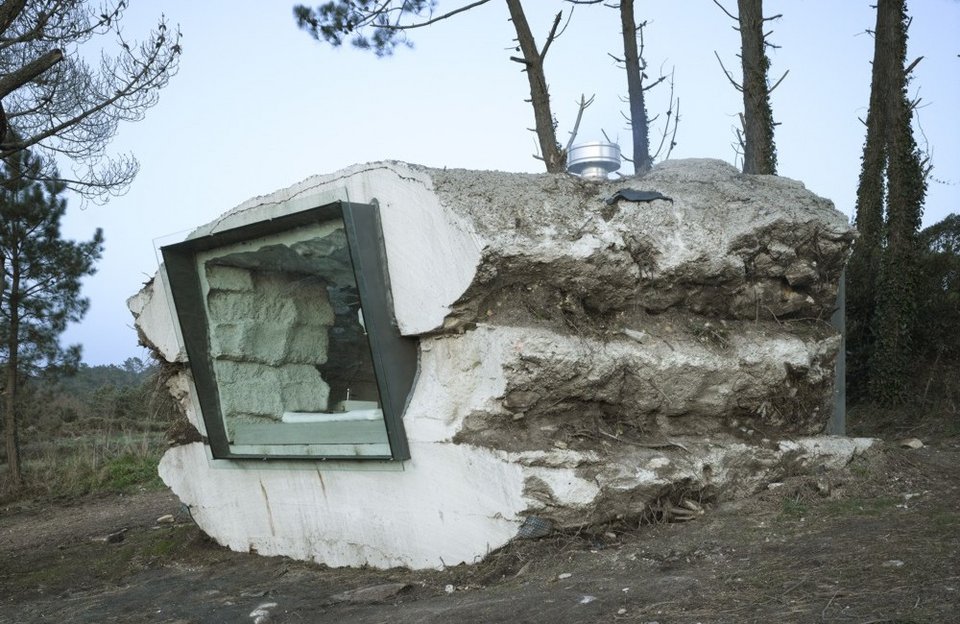
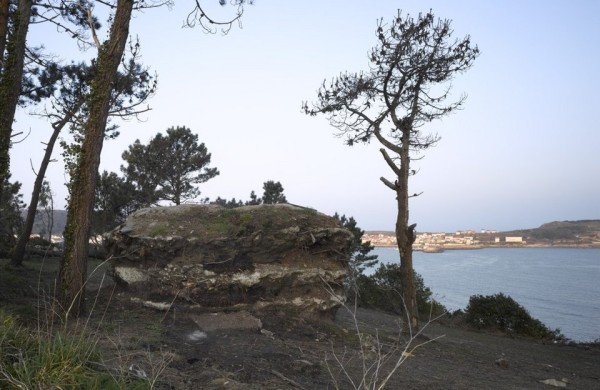
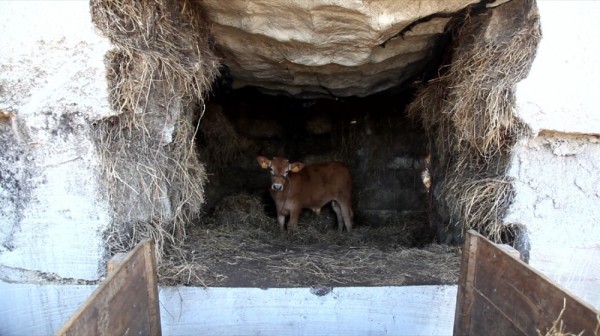
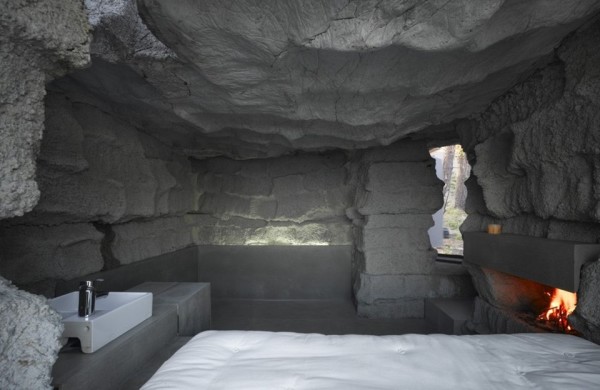
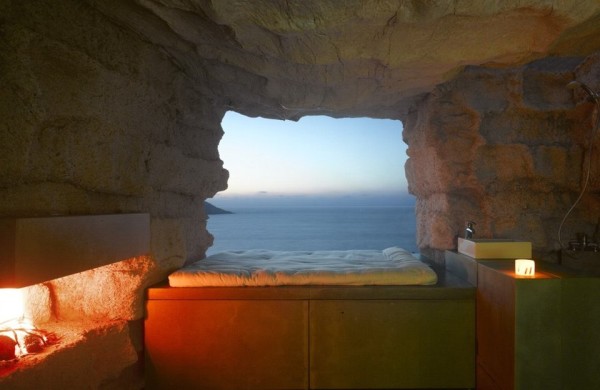
I love how unconventional and off the wall the thinking behind this how is! It’s these kinds of crazy awesome unexpected ideas that will help us solve our environmental and social issues. Thanks for featuring this!
This thinking solves nothing.
Let’s see, dump tons of concrete into a hole using large trucks, diggers, explosives, giant rock cutting diamond saws. And for what? to build a small place so that social creatures can be isolated? It’s this thinking which has gotten us in trouble in the first place.
SteveR is “right on”. This in fact it antigreen. Any time a person has to spend one green back dollar he becomes antigreen. We cannot have it both ways. Tinyhouses are typically antigreen, just figure the cost per square foot to find the antigreen component.
For those who think it resembles a womb, do I ever feel sorry for you. You obviously know some big ugly ladies. The wombs I am familiar with are much smaller, softer, look and smell a whole lot better. plus an entire cow (or bull) cannot trample around inside it let alone eat it out. I’m not man enough for that and I admit it.
If people really want to know what green is and how to live green, then shut up and listen and watch the Great Native American Indians. They did everything without a single greenback dollar or nuclear weapons and prospered very well. They had their own Super Walmarts that provided everything they needed, cloths, food, tools, cooking and heating fuel and not one greenback was needed. They required no parking lots or fences. They were simply called “Buffalo”. Then the nasty Europeans came with all their diseases and religions and bad ideas and killed off most of the Indians (the worlds worst genocidal holocaust) along with the Buffalo to gain where we are today. How soon we forget what green really means and what life and living is all about.
Thank you for writing this amazing article.
I thought it was a ‘found boulder’ until I watched the video and I was kind of shocked, so I appreciate your comment too. Its a shame no one mentions the American Indian genocide either. The tribes were not united, and I’m sure were territorial among themselves, which I guess made them easy pickings for when Europeans saw the value in this land. I want to look forward now because this is the time space I am living in. I want to take what the Indians taught in their close relationship to the land, and use as much of it in my life. If I knew how to set up a teepee it seems fun to live in but my neighbors might protest, although, maybe not. Probably the city ordnance would have something to say about wind velocity measures.
Native Americans had significant impact on the natural world – they had intensive gardens (their development of corn still stands as one of the most awesome achievements of domestication and genetic manipulation of a crop), they managed the forests large-scale, they even had cities. But in 1618 and 19 , there were epidemics that wiped out between 50 and 90 percent of the population — just in time for the Mayflower pilgrims to arrive, who marveled at the cleared land and gardens they found. Oh yes, and Squanto – he spoke to them in English, because he had spent a good ten years or more in England already. He went to England before the epidemics, and arrived back afterwards, to find his village deserted.
Agreed how could this be practical.. such a waste
An excellent A-Typical construction project 🙂
That’s a lot of work for a manmade cave. I prefer something not so solid/unnatural. If it’s going to be something that lasts a long time, I personally wouldn’t want that – rather make a stone cave/cellar.
Interesting concept, grabs attention.
However….it’s difficult to see anything inviting in this place. It certainly comes off as cold and claustrophobia-inducing.
And what’s with the sink at the foot of the bed? “Highly illogical!”
I love it. Inviting it’s not but cozy and practical for survival are key. It’s awesome!
Interesting to say the least, not a bad getaway hangout to go meditate or just be alone and think. Yeah, it’s not so beautiful on the outside but I do think for the view and to keep out of the rain with a fireplace, its a wonderful place to reflect.
Seems like a whole lot of trouble and work to go through. Just to end up with what the finished product is….
Taking it all into consideration this is an exercise in form….
..it’s a form of art….
…it has to be French in origin.
Cool. Kind of a modern monastic cell. Good place to reflect and meditate in comfort. Not to mention a very happy bovine assistant.
I love the concept! Affordable, cozy… with lots of character. Ms. Minimal approved!!
Call me crazy but I feel it has a very womb-like feel to it. Perhaps the sink could be place someplace more logical and room could be made for a cooler. I can think of several ways to arrange for storage, though not much. My main concern is the environmental impact of using concrete. Possibly some form of adobe would be better?
I really like it! There are so many possibilities for utilizing the space.
I, too, thought of adobe, natural clays, hand applied, though perhaps less durable. The small size invites a hands-on technique. Love the ocean view and especially Paulina’s enchanting
contribution!
It’s cozy enough; but I would have to put a bit more energy into decor. I’d go stir crazy in a place that was that industrial looking. I need some color, some design to tease the eye. If I want mere cave survival, I’ll look for a property with an existing cave and move in with minimal decor. But I just can’t live that way… Paint my home with rainbows! Make my place festive… but not quite Carnival… Life should be a daily celebration of life… not a dismal ‘survival pad’…
I don’t want to merely survive: I want to live. And I cannot live without color, pattern, rhythm…
Umm….Paulina looks like a Paul to me. Just a little bull.
Sort of looks like a truffle. Perhaps pour some chocolate over it and serve with white wine.
More like a tomb than a womb to me. I think I’ll pass.
I totally love this! These folks have a very weird sense of humor. I mean, it’s not very “green” so to speak, but it’s totally discreet and natural looking from the outside…who would ever know this was a little room? PS, cow, who doesn’t love a happy cow.
Pauline looks to be a bull not a cow!
This sucks.
Hope it’s warm there, it would be hard to keep all that concrete even 98 degrees. Interesting experiment and design concept.
This does suck in many ways. I don’t think there is any innovation and it seems completely frivolous. But they obviously had fun implementing it and it still inspires me. I just wish they used
hemp/lime(crete), left some strawbale in as insulation and inplemented an alternative to the steel reinforced roof rather than just being an architectural experiment flawed with BS. Brilliant and awfully stoopid at the same time!
Is this the beginning of a SLOW HOUSE Moovement? 😉
Coming from a building code/structural background, I find it hard to believe that an architectural firm wouldn’t reinforce the concrete with rebar!!! When I look at the convex shape of the ceiling, it looks like it is already caving in and that makes it feel claustrophobic. I’d never be able to rest in a place where I felt that the ceiling could come crashing down any minute and entomb me there! Other than my structural concerns, I think it is an interesting idea.
I think this type of poured-in-place concrete construction was implemented much more beautifully and functionally, albeit on a much larger scale, at Fonthill in eastern PA. Some of the domed rooms there, with inlaid tiles and beautiful built-in furniture, are quite gorgeous.
The video was a little weird and hard to fallow, but then again I’m not a Architectural designer.. But I do remember as a young lad trying to build forts in the same manner, but with rail road ties as our structure …. Can’t wait to see more homes of this type and expect to see them more because of all the hub bub on doomsayers….!
How many beer did y’all have? Fun though.
Many are too critical here. I don’t recall this being billed as a green experimental structure, so critiquing it solely on that basis is unfair. It has a visual appeal from the outside that is less intrusive to the site than would be most human-made structures. I’m not sure about the climate, but I’m guessing that the occupant probably requires more cooling than heat, which would make the uninsulated mass suitable. The interior does resemble a cave, which some people like (there are areas where caves are not uncommon dwelling spaces). Moreover, there are ways to build this type of structure that would be greener, and warmer (both physically and visually)–try cob or earthbag construction. Even using cement, you could do this without the machinery by substituting sweat equity and planning entrances that would not require cutting. Also, I found the video interesting; the construction technique resembles that used to build cob or beehive bake ovens. The longer video (which pops up at the end of the one here) shows alternative floor plans. I think this experiment was a success in many ways, even it doesn’t suit my own or your particular tastes or needs.
i thought it was just me who looked at it and saw a lot of work for such a small space. I was like… “I dont get this at all” LOL!
I kind of just love that they used a cow for this architecture experiment. I feel like this has the makings of an interesting film.
Yuck! It’s an ugly uninviting cold hole in the ground. They could have made something much nicer with less than half the effort and money.
Sorry folks, this one looks more like a dungeon or military pillbox, not a cozy home.
useless video…explains nothing from what’s being done to why do it…..